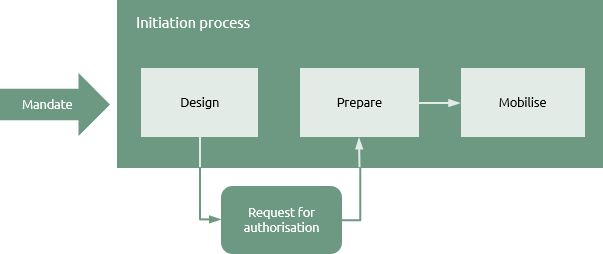This is usually a one-off process. It represents the point at which the host organisation makes the decision to manage its projects and programmes as a portfolio.
The goals of the process are to:
- decide what type of portfolio is required;
- design the portfolio infrastructure;
- obtain senior level approval and commitment;
- implement the portfolio.
Broadly speaking, the decision to create a portfolio has three purposes.
Firstly, to co-ordinate projects and programmes that draw upon a common pool of resource. This is to maximise the efficient use of available resource and avoid conflicts in resource requirements wherever possible.
Since portfolio initiation is usually a one-off process, Praxis does not contain a corresponding maturity definition.
Maturity of portfolio management is assessed by the way the portfolio is governed and managed rather than how it is set up.
Secondly, to promote a consistent approach to project and programme management. This focuses on developing competency in individuals, capability in functions and maturity of process.
Thirdly, to manage a set of projects and programmes that collectively achieve a set of strategic objectives.
The three purposes are by no means mutually exclusive. In fact they are complementary. A ‘standard’ portfolio will be primarily about the first purpose. It would typically apply to a contracting organisation that delivers project and programmes on behalf of clients. Although each project and programme is distinct and has a different client, the host organisation that owns the portfolio delivers them using a common pool of resources.
In some cases, multiple clients may stipulate multiple approaches to project or programme management. The contracting organisation has to manage using different client processes and documentation. Where the management approach is chosen by the contracting organisation it makes sense to use the portfolio for the second purpose of managing all projects and programmes in a consistent way. This will make the mobilisation of managerial resources far easier since they will all have common competences and operate common processes.
A structured portfolio is designed to achieve the third purpose, i.e. the delivery of a set of strategic objectives for its host organisation. It is probable that this will require the efficient use of a common pool of resources and will inevitably benefit from a consistent managerial approach.
Therefore, both standard and structured portfolios will be designed with the efficient use of common resources in mind. In a standard portfolio this may be its only purpose. A structured portfolio will primarily be created to achieve a single set of strategic objectives.
Depending on the context, a standard portfolio may be able to apply a consistent managerial approach across all projects and programmes. A structured portfolio will invariably seek to achieve consistency across its component projects and programmes.
Click on the components of the diagram for more detail

Design
Just like projects and programmes, a portfolio will start with some form of mandate. The mandate will give someone the task of initiating a portfolio. This person may be a board member or suitably senior manager who will become the portfolio’s sponsor.
The mandate will probably give some indication of whether a standard or structured portfolio is required but full consideration of that matter is part of this activity.
The ‘sponsor designate’ will need to assemble a small team to investigate the way a portfolio should be constituted and governed to best suit the needs of the host organisation. The result will be a proposal that is submitted for authorisation to the issuer of the mandate.
Portfolios are rarely created from scratch. It is more likely that an organisation that has several projects and programmes decides to collect these into a portfolio to improve management and/or focus on strategic objectives.
Back to diagram
Prepare
If the proposal is accepted then preparatory work is commenced. Depending upon the type of portfolio and its context, this could include:
- identifying and documenting managerial processes and documentation for consistent use across all projects and programmes;
- preparing standard management plans;
- setting up a competency framework to act as the basis of training and role definition
- defining the infrastructure;
- reviewing existing projects and programmes to capture good practice and baseline capability maturity;
- communicating the impact of portfolio management across the host organisation.
The ‘prepare’ and ‘mobilise’ activities should be run as a project or programme with objectives described in terms of outcomes. These outcomes will define the way the portfolio will work.
In effect, the objectives for this project would be a blueprint for the operation of a portfolio.
It is highly unlikely that this preparation will start with a totally blank sheet of paper. The organisation will be managing projects, and possibly programmes, and these will already have processes, procedures and documentation standards in place. These existing methods may not be consistent and will be of variable quality.
During this activity all existing methods should be assessed and the current best practice should form the basis of new portfolio-wide standards.
Back to diagram
Mobilise
The implementation of a portfolio will often require significant change management. If the systems and processes of portfolio management are to be embedded for long term benefit, the existing organisation will have to undergo change, not just in terms of physical infrastructure but also in terms of attitude and behaviour.
Mobilisation may include aspects such as:
- setting up governance structures;
- initiating training programmes in line with the competency framework and standard processes;
- amending recruitment and appointment processes;
- implementing information management systems;
- adopting existing projects and programmes into the portfolio.
Back to diagram





